
|
model interpretatiu
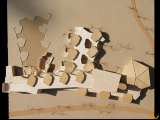
|
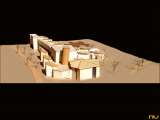
|
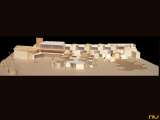
|
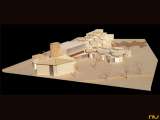
|
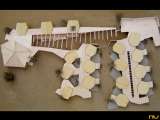
|
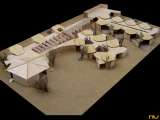
|
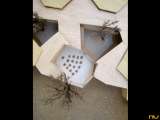
|
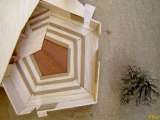
|
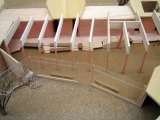
|

|
redibuixat
|
|
Liceu femenﺣ de Lunen, plﺣ nols |
anﺣ lisi
|
El Liceu Femenﺣ de Lﺣﺙnen, Westfalia, va ser disenyat en 1956, cinc anys desprﺣ۸s del projecte de Darmstadt i es va desnvolupar en diverses etapes entre 1956 i 1962. L'edifici es situa al sud del centre histﺣﺎric de Lﺣﺙnen, mﺣ۸s enllﺣ de les seves muralles que es fonen amb una gran zona verda. Molt aprop de l'escola cap al nord, roman una esglﺣ۸sia neogﺣﺎtica que actua com una fita vertical amb la que l'escola, massa horitzontal i zigzaguejant, buscarﺣ۰ contrastar-se. El programa inicial corresponia al d'una escola secundaria per nenes, d'edats compreses entre 10 i 18 anys, dividides en tres grups o graus: inferior, mig i superior. Scharoun va organizar el projecte a partir d'una espina circulatﺣﺎria que corre paralﺡﺓlela a la antiga muralla i de la que es desprenen dos grups d'aules en planta baixa, corresponents als graus mig i inferior. Les aules del grauo superior es situen a la planta superior seguint la direcciﺣﺏ de l'espina principal. Si be les aules a Lﺣﺙnen tenen una estructura mﺣ۸s ﻗuniversalﻗ i flexible que les mﺣ۸s especialitzades de Darmstadt, Scharoun insisteix en la creaciﺣﺏ d'una Klassenwohnung, ﺣ۸s a dir, d'una identitat entre l'habitar i el pensar. Cada classe es composa d'un espai principal de docﺣ۷ncia, annex, lobby d'accﺣ۸s i espai extern. Per compatibilizar les dues funcions de classes de pisarra o seminaris, l'espai de l'aula adopta la forma d'un hexagon allargat que, junt amb un mobiliari lleuger, resol ambdﺣﺏs compromisos. La ilﺡﺓluminaciﺣﺏ s'aconsegueix mitjanﺣ۶ant unes finestres claristori presents en tot el perﺣmetre a les que se li afegeixen els panys vidriats complets que donen als espais exteriors adjacents. La relaciﺣﺏ entre aula i espai extern varia segons el grau, resultant mﺣ۸s oberta en els graus inferiors i tancant-se en relaciﺣﺏ a un espai quasi claustral, en els graus mitjos. Els serveis es situen al final dels passadisos centrals de cada grup d'aules. L'espai de la assamblea de l'escola, pasible d'utilitzaciﺣﺏ pﺣﭦblica, es sitﺣﭦa aprop de l'entrada principal que actﺣﭦa com una cantonada en connexiﺣﺏ amb el carrer a travﺣ۸s d'un passeig peatonal. La forma poligonal i centrada de l'assamblea busca mostrar un exemple d'aquests espais aptes per l'intercanvi i el sentit comunitari que Scharoun havia convocat en les seves ﻗaquareles de la resistﺣ۷nciaﻗ. Els tres anfiteatres de ciﺣ۷ncies, separats pels laboratoris, es colﺡﺓloquen al costat nord de l'edifici, en oposiciﺣﺏ a l'assamblea. Les classes d'arts i oficis es situen a la planta alta, sobre la primera part de la espina circulatﺣﺎria i rematant pel costat oest la tira dels graus superiors. Un lloc de trobada cobert i orientat a sud s'extﺣ۸n en planta baixa, entre l'assamblea i les aules del grau mig, en un nivell mﺣ۸s baix que el de la circulaciﺣﺏ principal, rebent la seva forma d'una serie d'elements independents que pretenen afavorir el moviment espontani del carrer o del pati. (F.A.P.) |
obres relacionades
|
Escola de Darmstadt
Escola primaria |
bibliografia
|
Redibuixat i model interpretatiu realitzat per: Patricia Jaime, Josﺣ۸ A. Remﺣﺏn, Rhona Okafort |
|
BLUNDELL JONES, Peter. Hans Scharoun. Londres: Phaidon Press Limited, 1995 BﺣRKLE, J. Cristoph. Hans Scharoun. Zurich: Artemis, 1993 MARCIANO, Ada Francesca. Hans Scharoun, 1893-1973. Roma: Officina Edizioni, 1992. PFANKUSCH, Peter (ed.). Hans Scharoun, Bauten, Entwﺣﺙrfe, Texte. Berlﺣn: Gebr.Mann Verlag-Academie der Kﺣﺙnste, 1977. STABER, M.. Hans Scharoun. Ein Bertag zum Organischen Bauen, en: Zodiac nﺡﭦ 10, 1962, pp. 52-85. |
comentaris/assaigs
|
|
Alvarez, Fernando. "Hans Scharoun. El largo final de la Glaskultur." (Guions de classe: Histﺣﺎria de l'art i l'arquitectura, 2009). |






